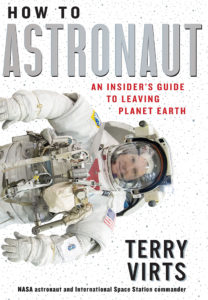You’ve been over-the-moon before. Just not in the way you want. No, you’re someone who needs to see the Earth for yourself, from two hundred thousand miles up. You want to experience weightlessness, extreme g-forces, and you want to walk among the stars. In “How to Astronaut” by Terry Virts, you’ll see that doing so could put you into a whole new orbit. Ever since you were little, astronauts have been your heroes. They’re elite scientists and you know that being hired by NASA isn’t something that happens to just anybody. Says Virts, his career started when he was just seventeen years old, when he joined the Air Force to learn to fly jets. It was there, he jokes, that he discovered an essential skill: he learned “to sound cool on the radio.” Of course, there are other things you’ll need to know to NASA – how to speak other languages, for one. How to recognize when you’re about to die from lack of oxygen is important. Or this: how not to break limbs when riding “The Vomit Comet” and how to perform basic medical procedures if someone does. An astronaut also needs to know what “the red button” is and why it shouldn’t be touched. Once you get the technical training out of the way, astronauting requires knowing everyday logistics. Virts learned, for example, that zero-gravity makes a great extra hand when doing projects. He learned how to pack for six months in space, and how to pick the best underwear for the journey. Astronauts must know how to prepare meals among the stars, and they must learn how to properly potty, while there, also. They need to exercise, wash up, get dressed, get a haircut, log onto the internet, and watch TV while floating. Astronauts must be curious and resourceful. While on a space capsule, they need to know how to live – although sometimes, they will die. Ask around, and you’ll see that just about everyone has enough trouble living on land, so… astronauting? Yep, it’s got its challenges, but this author, NASA astronaut, and International Space Station commander Terry Virts makes it seem like any other job. Granted, it’s a job with a 40-plus-pound uniform and coffee breaks are made of you-don’t-want-to-know-where-it-comes-from water, but even inconveniences appear as privileges in Virts words – and yet, this isn’t a book full of platitudes. Instead, Virts writes about those things that readers have always truly wondered about life in space, including both personal and mundane activities, the tricky stuff, and those behind-the-scenes scenes that you didn’t even know you wanted to know. He does it with a minimum of technical language but a maximum of humor that doesn’t descend into the jokey, making this book very, very readable. And fun, too – lots of fun that, except for a few minor grown-up asides, makes it something that older teens can enjoy, as well as adults. So, go and get “How to Astronaut” for your bookshelf. I promise, it’ll do more than just take up space.

